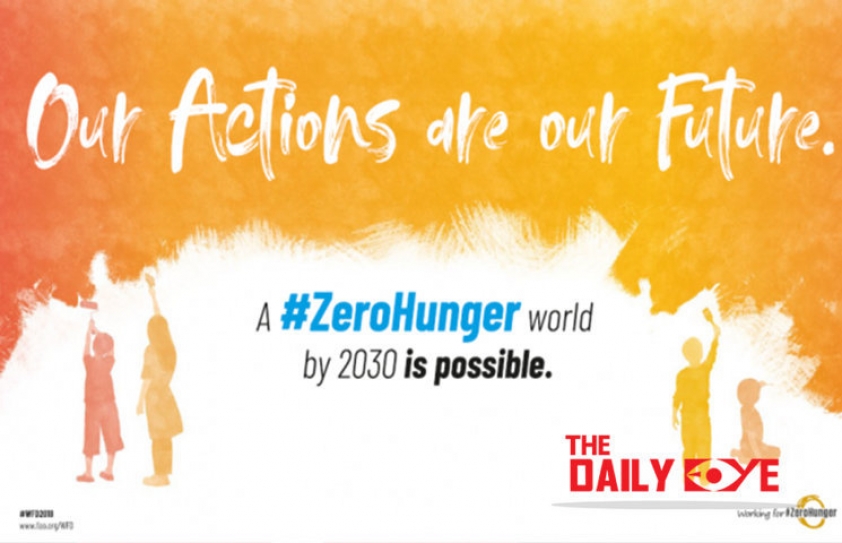
UN’s Key Priorities to resolve Hunger this World Food Day
by Shruthi Venkatesh October 24 2018, 6:11 pm Estimated Reading Time: 5 mins, 54 secsWorld Food Day is celebrated around the world every year on 16 October in honour of the date of the founding of the Food and Agriculture Organization of the United Nations in 1945. The day is celebrated widely by many other organizations concerned with food security, including the World Food Programme and the International Fund for Agricultural Development. This year the theme for the World Food Day was: ‘Our actions are our future’. With this theme, the UN and its partners, held events and launched information campaigns worldwide, to amplify one message: achieving zero hunger by 2030 is possible only if we ‘join forces’.
World Food Day is celebrated in over 150 countries around the world. The principal reason behind launching and celebrating world food day is to secure and advance the food security across the world, particularly in days of the crisis. The commencement of the Food and Agriculture organization by the United Nations has played a significant role in making this possible and accomplishing the goal.
_1.jpg)
20 month old Ummi Mustafa and her mother. Maiduguri, Nigeria (IRIN News)
Hunger has been on the rise over the past three years, returning to levels from a decade ago. This reversal in progress sends a clear warning that more must be done and urgently if the Sustainable Development Goal of Zero Hunger is to be achieved by 2030. The situation is worsening in South America and most regions of Africa. With enough food to feed everyone on the planet, why are there so many hungry people? “In our world of plenty, one person in nine does not have enough to eat”, said United Nations chief António Guterres, marking World Food Day. Today, more than 815 people do not have enough food to eat. 25% of children under the age of 5 are chronically malnourished and may endure the effects of it for the rest of their lives. The majority of the world’s hungry people live in developing countries, where 12.9 per cent of the population is undernourished.
The UN has made to approach hunger and malnutrition as one of its key priorities. The organisation is contributing in number of ways looking forward to achieve the zero hunger in the upcoming years. Some of them are:
- Sustainable Farming
Since the 1960s, agriculture has managed to provide food for a population that has doubled from 3 billion to today’s 7 billion. But this is not sustainable. The agricultural sector has to find more ways in producing more with less water, less land and fewer resources. One such initiative is the consolidation of the Farm Business School (FBS). This publication comprises a collection of training materials that include: i) an orientation programme, ii) a short training for facilitators to set up and run farm business schools, (iii) a handbook aimed at providing guidance to trainers to design and implement the programme, and iv) a manual of training exercises. The goal is to help farmers adapt the new way of sustainable faring.
1.jpg)
End hunger, achieve food security and improved nutrition and promote sustainable agriculture (United Nations Lao PDR)
- Emergency food assistance
The World Food Programme (WFP) delivers relief food items, often overcoming tremendous logistical challenges during humanitarian crises or natural disasters. Most humanitarian agencies explicitly apply the principle of non-discrimination in their relief programs. In 2017, 91 million people received food assistance across 83 countries, and 18 million children received school meals across 60 countries. One way people can support directly is through the ‘Share the Meal’ Smartphone application, which has already enabled over 27.3 million meals to be “shared” with just one click in the Middle East, Bangladesh, Haiti, South Sudan and the Lake Chad region. As Smartphone users outnumber hungry children by 20 to 1, the UN believes this has the potential to make a real difference.
- End Malnutrition
Here, Poverty lies at the heart of the problem. Poor people are the most likely to be malnourished. Eradicating poverty is the key to ending malnutrition in all its forms. At the same time, eradicating malnutrition is the key to economic development: A well-nourished population is a healthier and more productive population. Ensuring that mothers are well nourished is another important action to take. Malnourished mothers are most likely to have malnourished babies. Programs that provide nutritious foods in schools are an example of what governments can do to address malnutrition in all its forms.
- To focus on local economic systems
As the world’s leading humanitarian agency, the World Food Programme (WFP) is a major buyer of staple food- some 80% of which comes from developing countries for a cash value of over US$ 1billion per year. Through the Purchase for Progress programme WFP itself has pledged to source 10 percent of its food purchases from smallholder farmers and also encourages government and private sectors to do so. Covering 35 countries, P4P has changed how more than 1 million small farmers interact with markets.
- Develop vulnerable projections and analysis
The Vulnerable Analysis and Marketing (VAM) by the WFP, enables the UN to monitor food security situations and market fluctuations in countries across the world. This initiative contributes decision making worldwide. The Climate Change and Food Insecurity Vulnerability Index – developed by the UK Met Office and WFP which was launched in Paris demonstrates how important large-scale action to both mitigate and adapt will be in our efforts to end hunger by 2030 and beyond.
- Empower rural women
‘Rural women form the backbone of rural societies’. Almost everywhere, they make crucial contributions to food production, food processing and marketing. Enabling and empowering rural women translates into improved overall well-being for children, households and communities, which in turn contribute to long-term social and economic growth. Evidence from Africa, Asia and Latin America consistently shows that significant improvements in food security can be achieved by expanding women’s access to productive resources and technologies, including land, market opportunities, decent employment and social protection, and by enhancing their role in decision-making at all levels.
- Raise awareness to spot the change
Government organizations and the private institutes must join hands for organizing events, debates, discussion, etc on the World Food Day for making general people aware of the security of the food in days of crisis and importance of agriculture to grow sufficient food. To meet the various targets by 2030, the UN is raising awareness with governments, the private sector, individuals and farmers. World Food Day is the best platform for creating such awareness.
“We know what needs to be done,” said FAO’s Graziano da Silva. “And we have to act now.” The sustainable development goal is to provide an even greater opportunity for both the developing and the developed world, not only to reduce poverty and hunger, but to go even further. The call for the elimination of extreme poverty and the end of hunger and all forms of malnutrition is to truly leave no one behind.





-173X130.jpg)
-173X130.jpg)


-173X130.jpg)
-173X130.jpg)
-173X130.jpg)